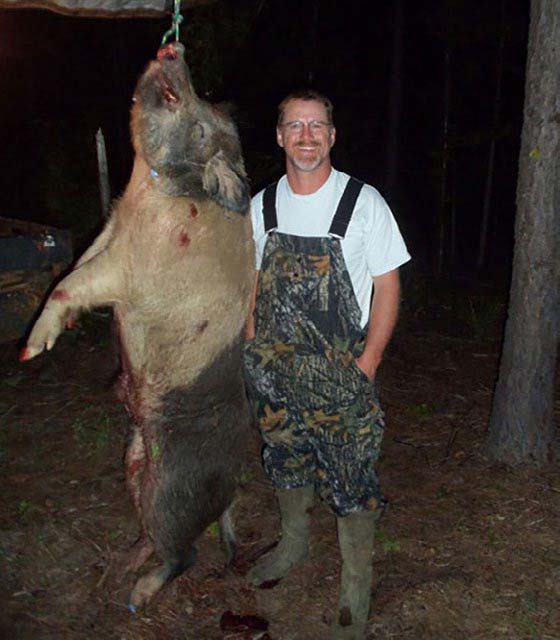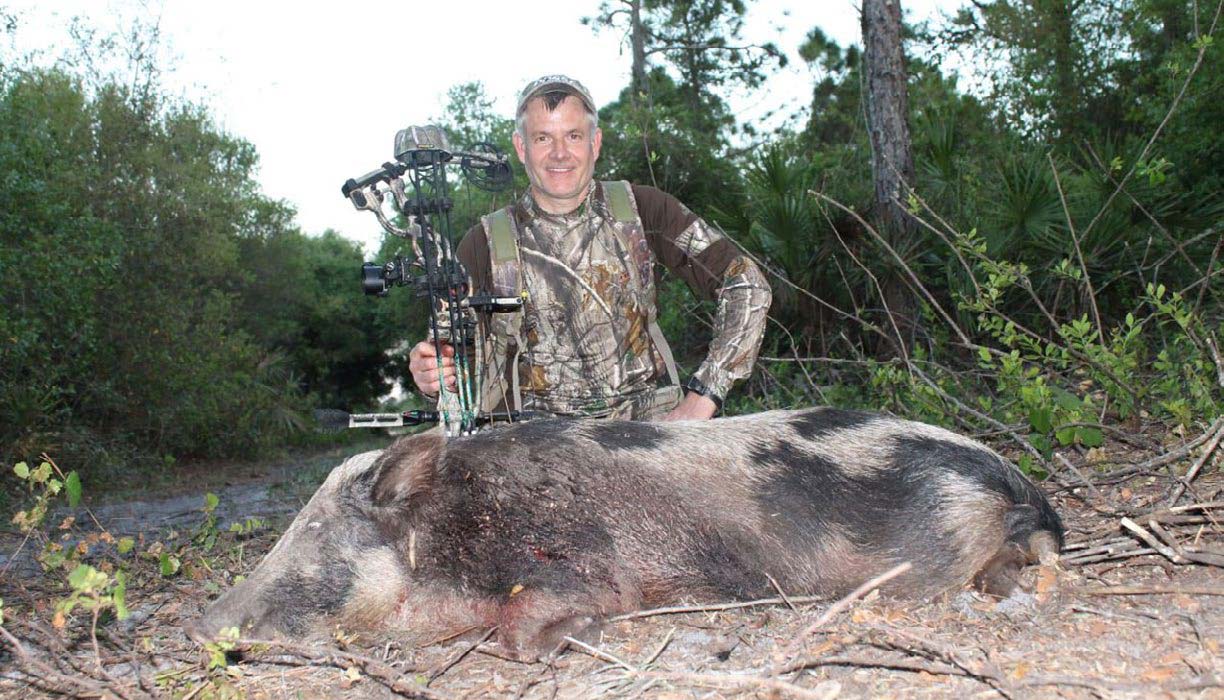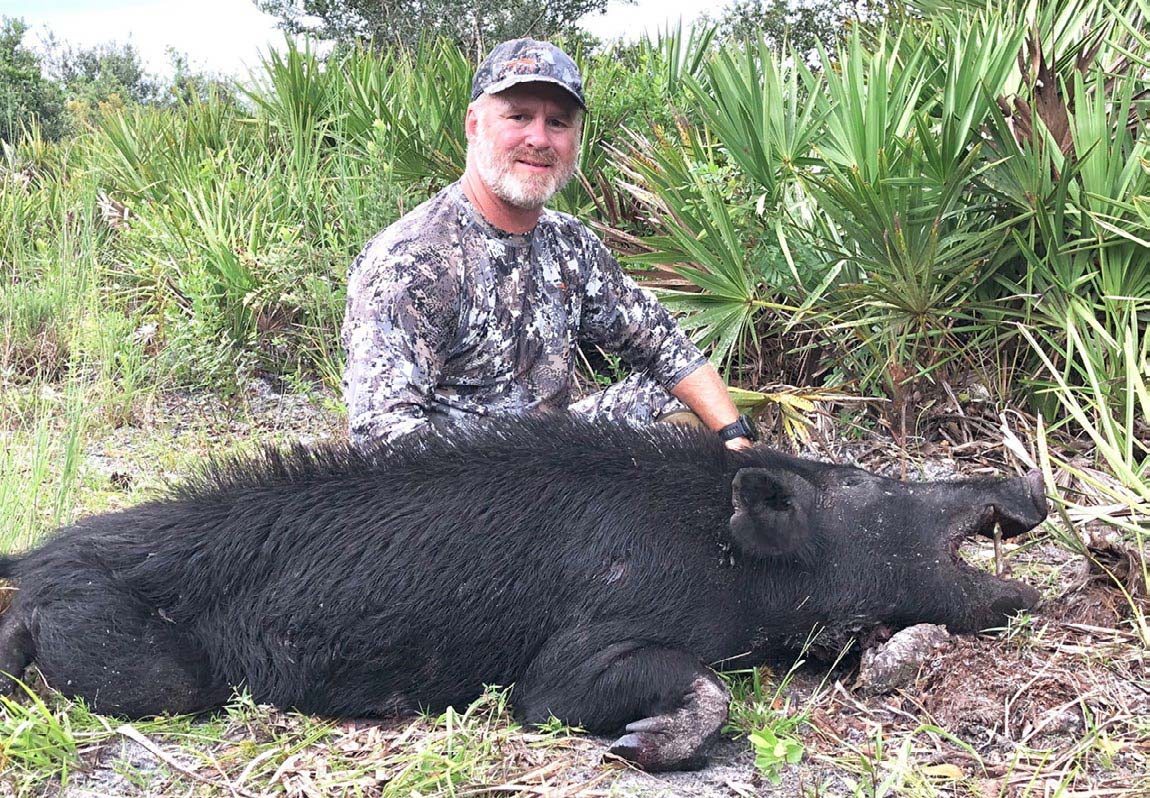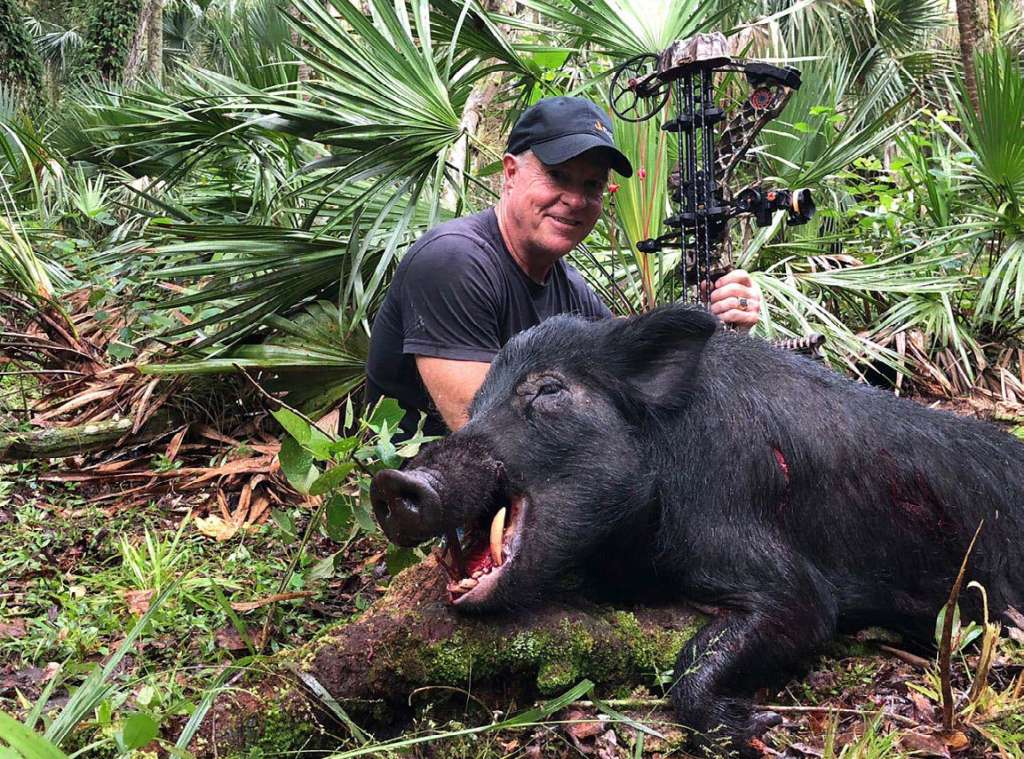Easing into the swamp, I heard the telltale grunts of a sounder of hogs feeding. Their social grunts can be heard at quite a distance in the southern swamps where I was bowhunting hogs. They were heading in my direction but were still too far away for me to locate. Easing behind a large cypress, I watched and waited. One by one, they began to appear as they fed along the creek. The sounder was large, with at least 20 animals milling around. My heart began to race, fearing that I would be spotted before the large black-and-white boar that was bringing up the rear presented a shot.
A small shoat fed past me on the right, then another white one fed past on the left. I sat motionless watching the big boar as it got closer. He went down to the creek to feed then moved back up the other side. At 13 yards, he presented the shot I had waited the past 15 minutes to take. I drew my Hoyt bow and settled the illuminated dot of my TruGlo Range Rover sight just behind the shoulder as I waited for the big boar to turn.
Bowhunting hogs, wild pigs, pigs, hogs, wild boars—whatever you choose to call them—is one of the most exciting forms of hunting today. In many areas of the country, there are no seasons or limits on how you can legally take feral hogs. Feral swine are considered a plague and a nuisance in some spots in the U.S. In other areas, they are a great resource for hunting and make fine table fare. While some locations use every means possible to eradicate feral hogs from their lands, other parts of the country are profiting from the hunting opportunities these formidable animals provide.
According to the United States Department of Agriculture (USDA), there are only two kinds of properties in the USA now: those that have feral hogs and those that will have them.

There are many theories about why a hog population explosion has occurred in the past decade and a half. One thing is sure: the growth has been massive. States that never had hogs now have them in abundance. States with historical populations of them have seen a spread and expansion of their territory.
Here in my home state of South Carolina, we have had hogs since our founding in the late 1600s. For the past 300 years, the hogs stayed relatively close to the rivers that flow through our state, with little expansion. They were largely confined to a few counties in the coastal plain. During the past 15 to 20 years though, we have seen an explosion in their population. Today, all 46 counties have healthy populations of feral swine and their numbers are expanding rapidly. A recent study showed that at the rate feral hogs reproduce (two litters a year of 6 to 10 babies each), and with no natural predators, their population in an area can reach mind-boggling proportions in a few generations. Charles Ruth, the project leader of the Department of Natural Resources in South Carolina says, “We would have to remove roughly 80% of the current population every year just to maintain the current population.” That is not possible. But efforts by state departments, the USDA, and sportsmen are doing all they can to keep the spread at bay…for now.
Expanded Opportunities
What this situation provides for hunters is an expanded season and more hunting opportunities. While there are weapon restrictions in some areas, the season doesn’t close. Check with your local state to see about the specific seasons and weapons allowed in hunting feral hogs.
There are basically three ways to hunt hogs across the country: still hunting, spot-and-stalk hunting, and using hounds. (I’ll discuss the first two options here. Hound hunting for hogs is such a large topic that I’ll cover that another time.)

Still Hunting
Still hunting for hogs is usually done over bait. Hogs have an affinity for shelled corn. Timed feeders are the easiest way to condition hogs to come to a certain location. Setting the feeder to disperse corn several times a day will get hogs into the area, and they will usually stay as long as the food is available. Elevated stands or popup ground blinds work well in this situation. If the feeder runs out of food, the hogs will move on. For new locations, allow a week to 10 days for the hogs to find the feed. Once that happens, they will regulate their patterns to when the food is available. My preference is to schedule the feeders to disperse feed an hour after sunrise and two hours before sunset. This (hopefully) gets the hogs to the feed during daylight hours.
Feeding hogs are always moving. Once you select a hog to shoot on a feed pile, do not expect him to stand still and give you a prime shot. You have to pick your spot and as soon as it is presented, then make the shot.
Bow hunting is an exciting method for hunting feral hogs. The silence of the shot and the skill needed to successfully kill pigs with archery equipment is as exciting as it can get.
Thankfully, in South Carolina, we can hunt feral hogs year-round with any weapon on private land. Being a dedicated archery hunter, I have an extended season. The equipment I use for killing hogs is very similar to what I use for Whitetail deer. A fast bow with a good broadhead and small-diameter arrows are all that’s needed to effectively kill hogs. My setup includes a Hoyt bow set at 58 pounds shooting Easton FMJ 5mm arrows topped with a SEVR expandable broadhead. This combination has led to a lot of pork in my freezer.
Tough Hides
Hogs are tough animals; they have a thick and it’s difficult to penetrate. Be careful that you do not put more emphasis on the power of your bow rather than the sharpness of your broadheads. It’s like trying to push a blunt nail through a piece of leather versus pushing a scalpel through a piece of leather. One takes a lot less effort. When a broadhead is razor sharp, it will blow through an animal with little to no effort. Lower-poundage bows are more than enough to effectively kill hogs when you shoot with sharp broadheads. I have begun to use traditional archery equipment to hunt hogs. A custom longbow with the same FMJ arrows and a fixed MONTEC broadhead has led me to find a lot of success.
Arrow placement is critical on hogs. It is well documented that mature hogs have a “plate” on their shoulder. If you ever cleaned a hog, you have seen this so will understand. This shield is very thick and difficult to penetrate. That’s why archery-equipment hunters are encouraged to only shoot hogs when they are presenting quartering-away shots.

My opening story illustrates this point. While the big boar was only 11 yards away, I needed to wait for him to turn away from me to provide a shot where I could slip the arrow in behind the plate and have it enter his vitals. Thankfully, he did turn. I settled the sight just behind his last rib and sent the Easton FMJ through the boiler room for a complete pass-through. He circled the tree I sat in for 15 seconds.
When we began cleaning the big boar, we discovered the shield was 1¼-inch” thick and hard as gristle. A shot through this would have stopped the arrow before it ever reached the vitals. If by chance it did hit the vitals, there would be no blood trail and we would have lost the pig. Understanding this is critical to making good ethical shots on your target animal.
Contrary to myth, sows have this shield also. While it’s not as thick, it is still present. Archery hunters need to understand that when a hog is over 100 pounds, shots that are anything other than quartering-away ones are questionable shots for those reasons.
While I prefer mechanical broadheads like the SEVR with a 1⅛-inch cutting head, smaller heads work better on hogs because of the animals’ thick hides and tough bone structure. Any fixed head will also suffice. Muzzy, Montec, and others all make great broadheads designed to kill quickly. Again, opt for the smaller diameter heads for hogs. Penetration is critical, and the smaller broadhead with thin arrows allows for greater penetration.
Elevated or Ground
Archers have the options of either hunting from an elevated spot or from ground blinds. Both are effective, especially when hunting over bait. The pop-up ground blinds help control scent on breezy days, while being elevated helps keep scent off the ground. Both are effective methods for harvesting hogs. The preference is to use a lock-on or ladder stand situated 15-20 yards from the bait. At 15 feet above the ground, the hogs totally ignore you, and this setup provides close, quick shots at good angles that let the arrow do its work.
Hunting hogs with archery tackle is about as much fun as a bow hunter can have. It is a great challenge and the harvest makes for fine eating. Bowhunting hogs is one of my favorite hunts. No one ever said about a hog, “You should have given him another year.” If you have a chance to chase some pigs with your bow, don’t miss that opportunity.
Read More: Hog Hunting at Night OR Deadly Pro Tactics for Bowhunting Turkeys
Per our affiliate disclosure, we may earn revenue from the products available on this page. To learn more about how we test gear, click here.







